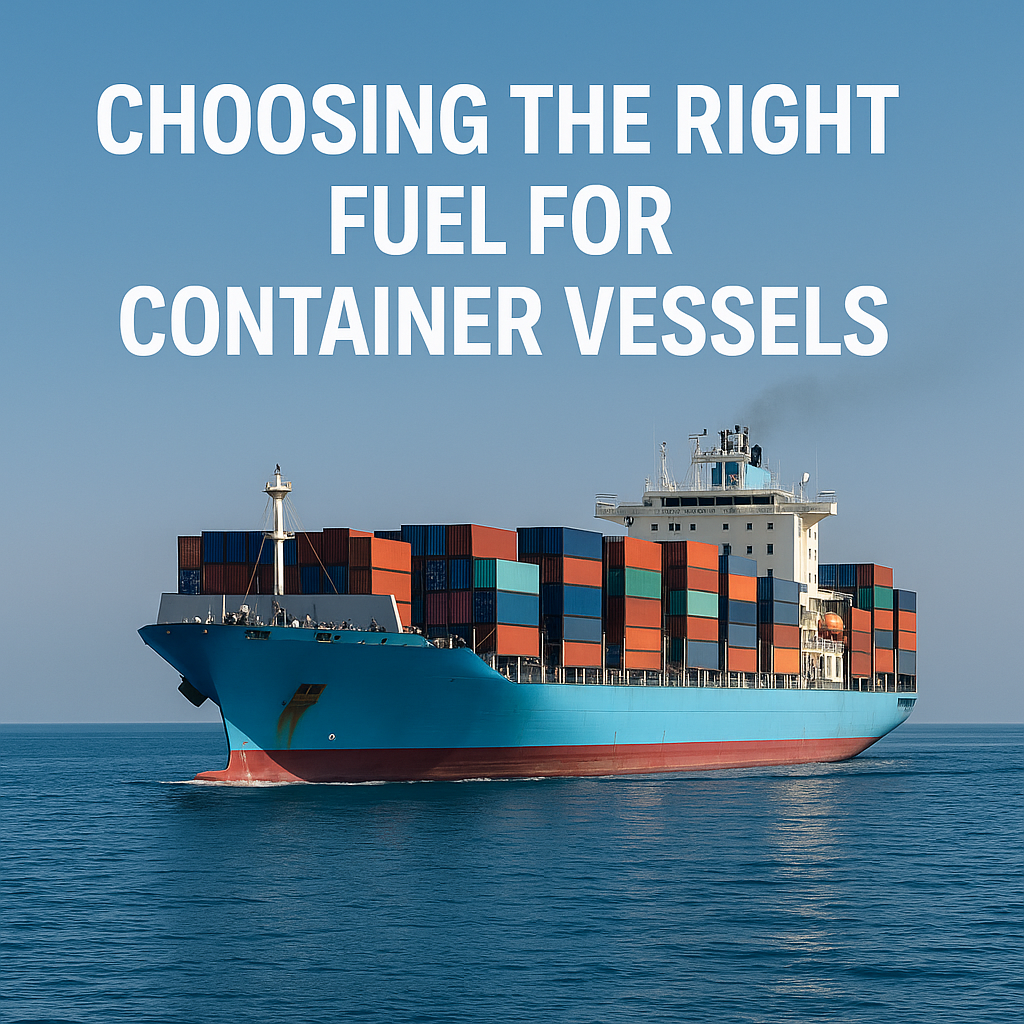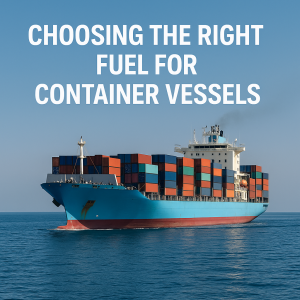Explore smart decision models for container vessel fuels. Learn how shipowners balance costs, emissions, and technology in the era of maritime decarbonization.
In the vast and complex world of maritime trade, the humble container vessel stands as one of the most critical engines of globalization. These ships transport more than 80% of global merchandise trade by volume, connecting supply chains and economies across continents. Yet behind the efficiency and scale of container shipping lies a mounting challenge: fuel choice.
Shipping currently contributes about 2–3% of global greenhouse gas (GHG) emissions, according to the International Maritime Organization (IMO). If unchecked, this share could rise to nearly 5–8% by 2050, placing the maritime industry at the center of climate debates. Regulations are tightening, cargo owners are demanding greener supply chains, and financial institutions are increasingly linking credit to environmental performance.
For shipowners and operators, the central question is no longer whether to move away from heavy fuel oil (HFO), but how and when. The difficulty lies in the fact that no single fuel has yet emerged as the universal solution. LNG, methanol, ammonia, hydrogen, biofuels, and synthetic alternatives all present opportunities but also carry uncertainties.
This is where smart decision models come into play. By applying structured methodologies that combine economics, technology readiness, regulatory risks, and environmental performance, shipowners can make informed choices about which fuel pathway aligns best with their fleet strategy.
In this article, we explore why fuel choice is so critical, examine the latest decision-making tools and technologies, assess the challenges, review real-world applications, and highlight what the future may hold for container vessels navigating the energy transition.
Why This Topic Matters in Maritime Operations
Choosing the right fuel for container vessels is not just a technical or engineering issue. It is a multi-dimensional decision with implications for compliance, competitiveness, and even reputational risk.
1. Regulatory Imperatives
The IMO’s 2023 Revised GHG Strategy sets a clear trajectory toward net-zero shipping by 2050, with checkpoints at 2030 and 2040. Compliance is enforced through instruments such as the Energy Efficiency Existing Ship Index (EEXI) and the Carbon Intensity Indicator (CII), both of which directly affect vessel certification and marketability.
In parallel, the European Union’s Emissions Trading System (ETS) and FuelEU Maritime regulation impose financial penalties for carbon-intensive fuels. From 2024, shipping companies operating in European waters must purchase allowances for their CO₂ emissions. By 2025, they must also meet declining carbon intensity thresholds. These measures make fuel choice directly linked to operating costs and competitiveness.
2. Market Pressures from Cargo Owners
Large shippers such as IKEA, Amazon, and Unilever are increasingly scrutinizing their supply chain emissions. Through initiatives like the Zero Emission Maritime Buyers Alliance (ZEMBA), cargo owners are willing to pay premiums for low-carbon shipping options. This creates a direct commercial incentive for shipowners to invest in fuels that reduce emissions.
3. Financial and Risk Considerations
Access to green financing depends on environmental performance. Banks aligned with the Poseidon Principles evaluate the carbon intensity of fleets when approving loans. Investors also view fuel strategy as a proxy for long-term resilience. Poor fuel decisions can lock fleets into stranded assets.
4. Operational Resilience
Fuel availability and bunkering infrastructure vary across regions. A vessel optimized for LNG or methanol may enjoy smooth operations on European or Asian routes but face difficulties elsewhere. Decision models must therefore integrate geographical trade patterns with fuel infrastructure realities.
Key Developments, Innovations, or Technologies
Smart decision-making in fuel choice blends engineering, economics, and environmental science. Several innovations are making this process more structured and data-driven.
Multi-Criteria Decision Analysis (MCDA)
MCDA is a structured framework where multiple factors — cost, emissions, safety, infrastructure readiness, and technology maturity — are weighted and compared. For container vessels, typical criteria include:
-
Capital expenditure (CAPEX): Cost of newbuild or retrofit.
-
Operational expenditure (OPEX): Fuel price, maintenance, and crew training.
-
Environmental impact: Lifecycle emissions, including upstream production.
-
Regulatory compliance: Alignment with IMO, EU, and regional policies.
-
Technology readiness: Commercial availability of engines and bunkering.
MCDA allows shipowners to simulate different scenarios (e.g., LNG vs. methanol vs. ammonia) under changing assumptions of carbon pricing, fuel cost, and regulatory tightening.
Digital Twins and Simulation Models
Advances in digital twin technology enable virtual modeling of vessel performance under different fuels. By integrating real-time data from sensors and predictive analytics, shipowners can estimate fuel consumption, emissions, and maintenance costs before committing to a technology.
For example, Wärtsilä and MAN Energy Solutions have both developed simulation platforms that allow shipowners to test fuel strategies virtually. This reduces uncertainty and improves decision accuracy.
Lifecycle Assessment (LCA) Tools
Smart models increasingly rely on well-to-wake lifecycle assessments rather than just tank-to-wake emissions. This captures the full carbon footprint, including fuel production and transportation. For instance, LNG offers a 20–30% CO₂ reduction compared to HFO, but methane slip during production and combustion can offset much of this advantage unless carefully managed.
AI and Machine Learning in Decision Models
Artificial intelligence is being used to forecast fuel price trends, carbon credit costs, and port readiness. AI-enhanced decision models can process vast datasets from market reports, regulatory documents, and ship operational profiles to recommend optimal pathways.
Challenges and Practical Solutions
Despite the progress, decision-making models face real-world challenges.
Fuel Cost Uncertainty
Fuel prices remain volatile. LNG was once seen as a low-cost alternative, but geopolitical crises (e.g., the 2022–23 gas price surge in Europe) demonstrated its vulnerability. Similarly, green methanol and ammonia are currently priced far higher than fossil fuels.
Solution: Scenario planning with sensitivity analysis helps account for volatility. Contracts for difference and long-term supply agreements can stabilize costs.
Technology Lock-In
Investing in a fuel that later becomes obsolete risks creating stranded assets. For example, LNG engines may face declining competitiveness if methane slip penalties tighten.
Solution: Dual-fuel vessels and modular retrofits provide future flexibility. Building “fuel-ready” ships ensures adaptability as technologies evolve.
Infrastructure Gaps
Global bunkering infrastructure for methanol, ammonia, and hydrogen is limited. A decision model that overlooks regional infrastructure constraints risks operational disruptions.
Solution: Incorporate geospatial data on bunkering hubs into decision frameworks. Green corridor initiatives can be used as anchor routes for initial deployment.
Data Quality and Transparency
Lifecycle data for alternative fuels is inconsistent. Without robust verification, shipowners risk greenwashing accusations or regulatory penalties.
Solution: Rely on data from recognized bodies such as DNV, Lloyd’s Register, and IMO GHG studies. Adopt certified schemes like ISCC PLUS for fuel sustainability.
Case Studies / Real-World Applications
Maersk’s Methanol Strategy
In 2023, Maersk launched the world’s first methanol-powered container vessel and ordered 25 dual-fuel ships for delivery by 2027. Maersk applied a decision framework that balanced regulatory compliance, customer demand, and supply chain availability. The company secured methanol supply agreements across regions, demonstrating how integrated decision-making supports both fleet and fuel ecosystem development.
Hapag-Lloyd and ZEMBA Collaboration
Hapag-Lloyd signed a contract with the Zero Emission Maritime Buyers Alliance (ZEMBA) to supply biomethane-fueled shipping services. Here, the decision model prioritized cargo owner demand and regulatory cost avoidance, showing that market signals can accelerate adoption of alternative fuels.
EU Energy Hub Modeling
European research hubs have simulated fuel adoption scenarios using energy system models. Results indicate that e-methanol and ammonia are likely to dominate by 2030–2040 if renewable energy scales sufficiently, highlighting the importance of integrating macroeconomic modeling into shipowner decision-making.
Future Outlook & Trends
-
Rise of Fuel Hubs and Green Corridors
Decision models will increasingly align with fuel corridor development in the North Sea, Mediterranean, and Pacific trade lanes. -
Carbon Pricing as a Game Changer
As carbon costs rise, decision models will weigh emissions more heavily than fuel price alone. By 2030, avoiding carbon penalties may outweigh fuel cost savings. -
Integration of Digital Twins into Fleet Management
Digital twin models will move from pilots to mainstream, becoming a standard tool for fuel strategy planning. -
Hybrid and Multi-Fuel Futures
No single fuel will dominate. Smart models will recommend multi-fuel pathways, where fleets diversify across methanol, ammonia, and biofuels to hedge risks. -
Growing Role of Financial Institutions
Banks and insurers will pressure shipowners to adopt fuels aligned with climate goals, embedding decision models into lending criteria.
FAQ Section
Q1: Why do shipowners need decision models for fuel choice?
A: Because fuel choice impacts compliance, costs, infrastructure compatibility, and long-term competitiveness. Models reduce uncertainty and improve investment confidence.
Q2: Which fuel is currently the best option for container vessels?
A: There is no universal answer. LNG, methanol, and biofuels are viable now; ammonia and hydrogen may dominate later. The “best” choice depends on trade routes, customer demand, and regulatory exposure.
Q3: Can existing vessels be converted to alternative fuels?
A: Yes, many vessels can be retrofitted, especially to methanol or LNG. However, costs and feasibility vary. Decision models help assess retrofit vs. newbuild options.
Q4: How do carbon markets affect fuel choice?
A: Carbon pricing under the EU ETS and future IMO measures increase the cost of fossil fuels, making green alternatives more competitive.
Q5: Are digital twins reliable for fuel decision-making?
A: Digital twins are not perfect but provide valuable simulations of vessel performance and cost scenarios, helping reduce uncertainty.
Q6: Will one fuel dominate shipping in the future?
A: Unlikely. Most experts predict a multi-fuel future, with methanol leading in container shipping, LNG in transitional use, and ammonia/hydrogen in long-term deep-sea applications.
Q7: How soon will green fuels be widely available?
A: Significant growth is expected by 2030, with large-scale supply hubs in Europe, Asia, and Latin America. Availability will expand as green corridors mature.
Conclusion
For container vessels navigating the energy transition, fuel choice is one of the most critical strategic decisions of the decade. Heavy fuel oil is no longer viable in the long term, and while multiple alternatives exist, each carries trade-offs in cost, technology, and availability.
Smart decision models provide the structured framework shipowners need to navigate this uncertainty. By integrating lifecycle emissions, regulatory exposure, infrastructure readiness, and financial implications, these models move fuel strategy from guesswork to informed decision-making.
As the 2030 deadline approaches, the message is clear: shipowners who invest in structured, data-driven fuel decisions will not only comply with regulations but also secure long-term competitiveness in a decarbonizing global economy.
References
-
International Maritime Organization (IMO). (2023). Revised GHG Reduction Strategy.
-
International Chamber of Shipping (ICS). (2022). Fuels for Shipping Decarbonization Report.
-
DNV. (2023). Maritime Forecast to 2050.
-
European Commission. (2023). FuelEU Maritime Regulation.
-
Lloyd’s List Intelligence. (2023). Alternative Fuels Market Analysis.
-
Wärtsilä. (2022). Simulation Tools for Fuel Transition.
-
MAN Energy Solutions. (2023). Dual-Fuel Engine Insights.
-
UNCTAD. (2022). Review of Maritime Transport.
-
Ocean Engineering Journal. (2022). Lifecycle Assessment of Marine Fuels.
-
BIMCO. (2023). Fuel Readiness Guidelines.
-
Port of Rotterdam Authority. (2023). Alternative Fuels Hub Development.



Normally I do not read article on blogs however I would like to say that this writeup very forced me to try and do so Your writing style has been amazed me Thanks quite great post